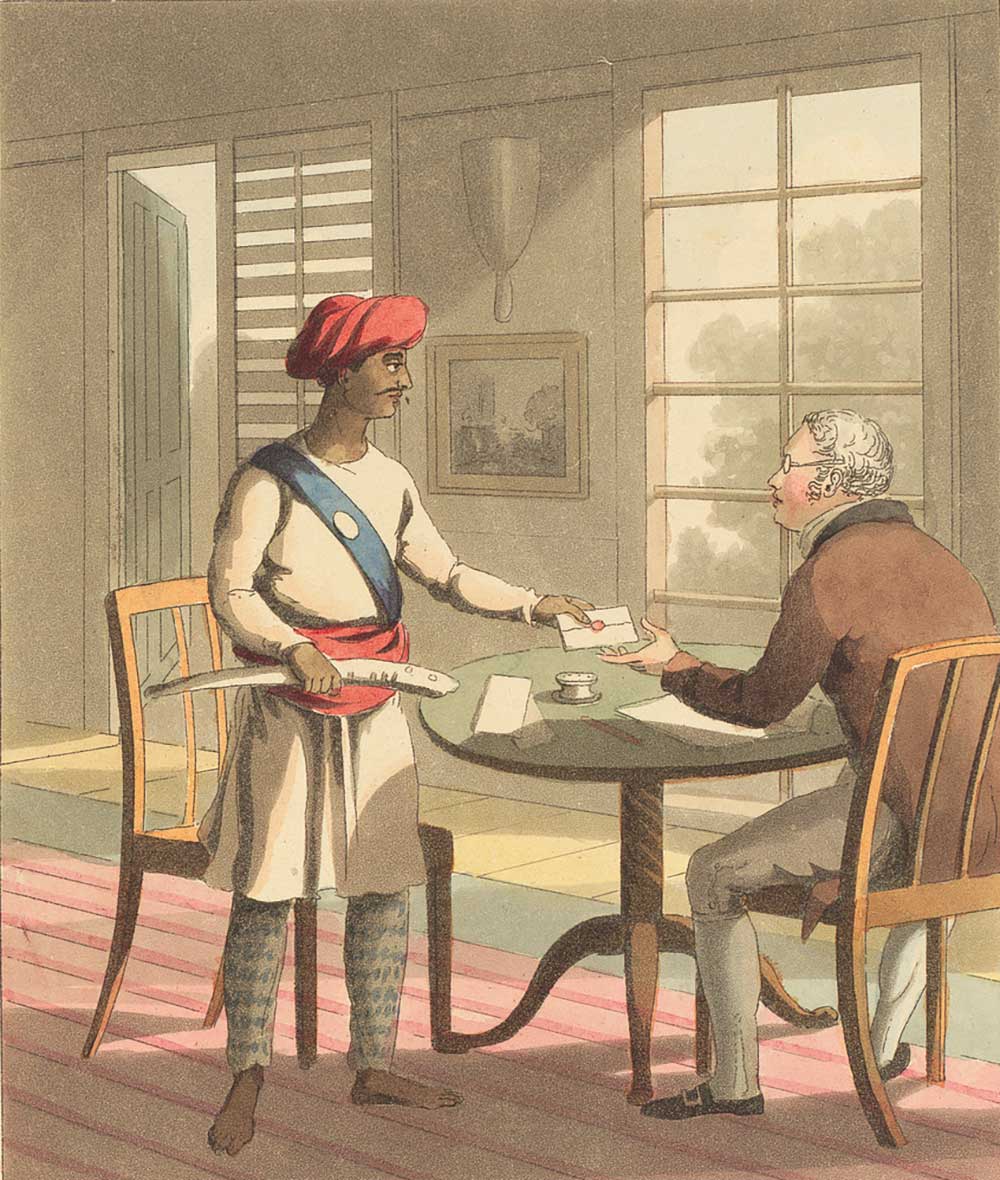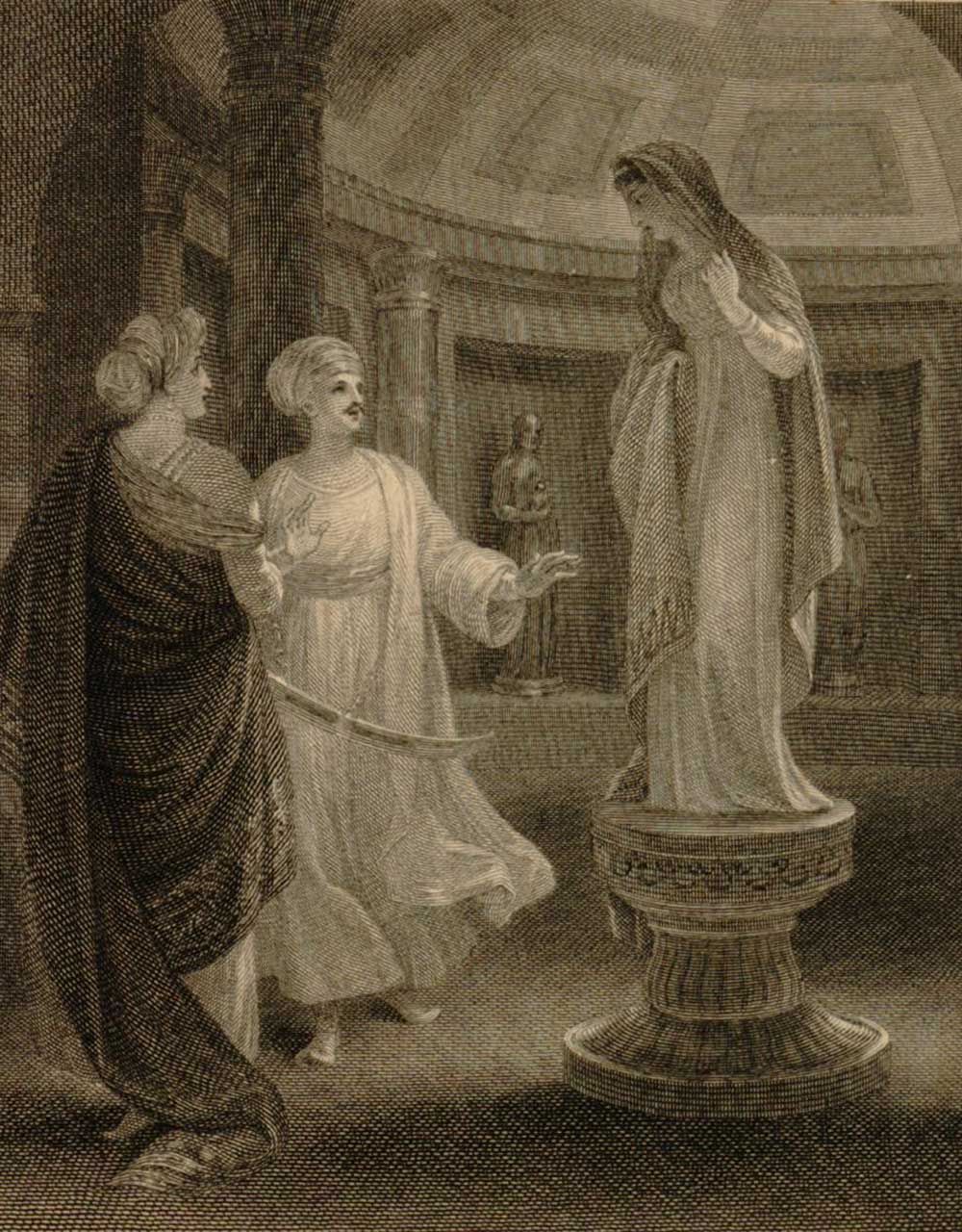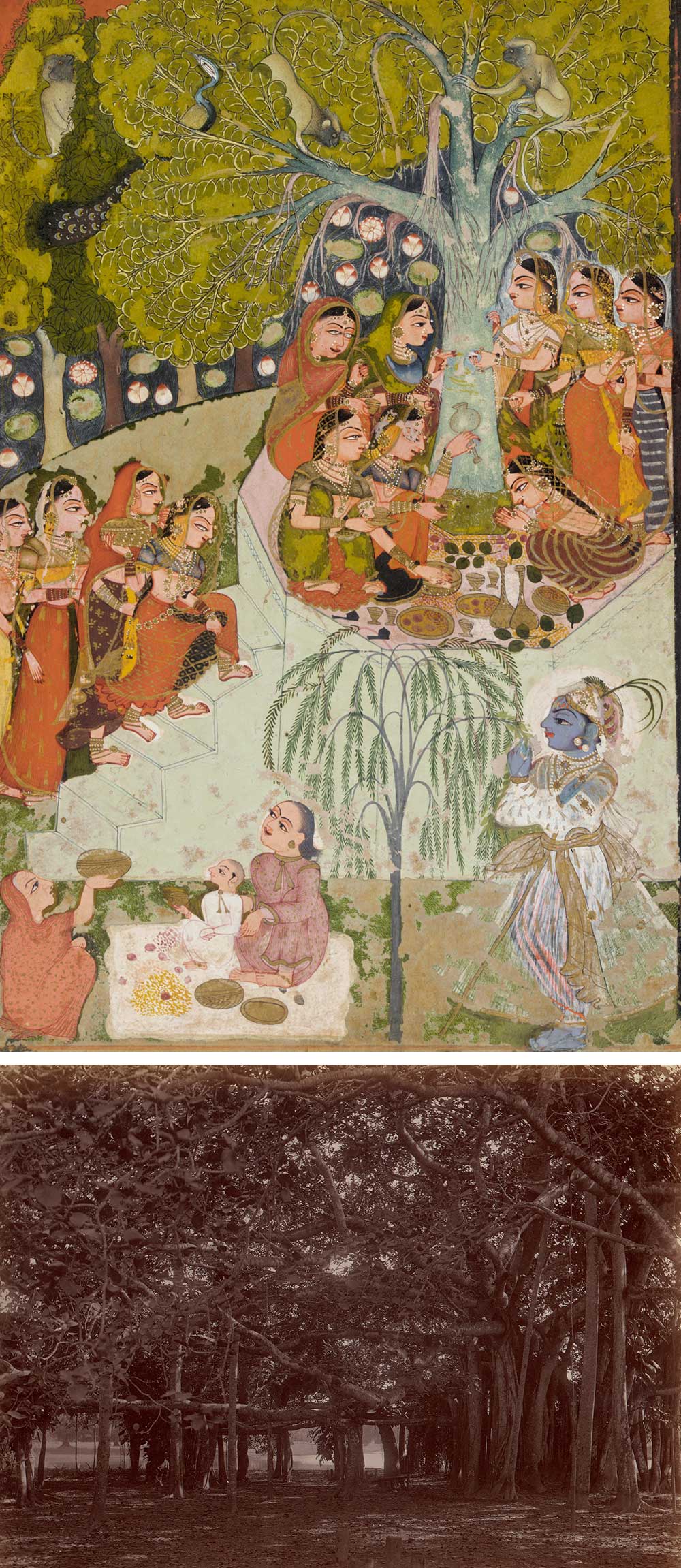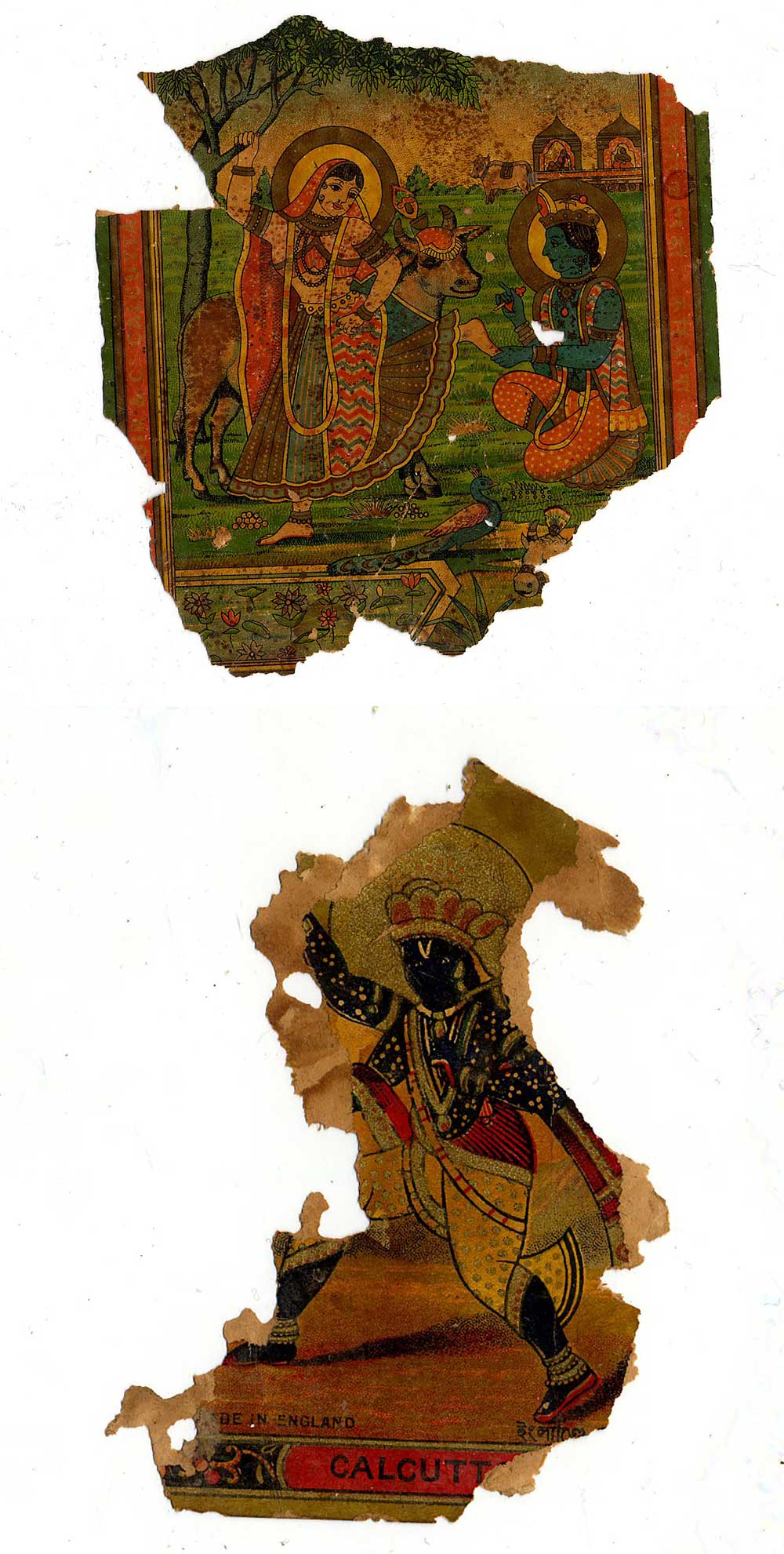In August 1783 an amazed Sir William Jones looked out from his perch aboard a frigate in the middle of the Indian Ocean. There was no land in sight. A few weeks earlier the Calcutta-bound Crocodile had departed the Comoros archipelago and sailed into the wide ocean gulf dividing the eastern coast of Africa from western India. On that evening Jones, a British polymath who had recently received his entrée into India’s imperial judiciary, reviewed the latest navigational data in the ship’s log and realized that he and the Crocodile had arrived at an interesting intermediate point. They lay nearly equidistant from three of the great historical civilizations of Asia. A breeze from the Arabian Peninsula might mingle above deck with a gust of wind crossing from Persia or the Indian subcontinent.
Months later, Jones described this moment of geographical orientation to a group of colonial functionaries gathered in Calcutta. “It gave me inexpressible pleasure,” he said, “to find myself in the midst of so noble an amphitheater, almost encircled by the vast regions of Asia, which has ever been esteemed the nurse of sciences, the inventress of delightful and useful arts, the scene of glorious actions.” The vista also provoked a moment of grief: Jones realized that few of his countrymen, were they in his place, would properly appreciate the view. It was an urgent reminder, he said, of “how important and extensive a field was yet unexplored”—the field of Oriental studies.
There is no certain date for when European scholars first thought to study the languages, histories, and religions of Asia within one academic discipline. Edward Said settled on a rather generous chronology for the field in his 1978 book Orientalism, dating the beginning of Europeans’ serious academic engagement with Asia to a fourteenth-century council of Catholic bishops who decreed that the leading universities of Europe should establish professorships in Greek, Hebrew, Aramaic, and Arabic. The field’s scope and methods changed at the end of the eighteenth century when, according to Said, European Orientalists established a profitable partnership with European imperial armies. Settling in newly occupied British and French colonies in India and Egypt, scholars began transferring antiquities, texts, and artwork back to Europe, believing that Asia could be as thoroughly studied as it was ruled.
If Said was correct, Jones’ vision on the Crocodile was an act of imaginative conquest, an attempt to assimilate Asia into his Eurocentric worldview. In one of several attacks on the eighteenth-century judge in Orientalism, Said wrote that Jones had “academically conquered” Asia with his “irresistible impulse always to codify, to subdue the infinite variety of the Orient.” This declaration would have surprised Jones’ contemporaries. His admirers believed that he conducted his research in the hope of tempering the worst effects of colonialism and furthering cross-cultural understanding. To Jones’ contemporaneous critics, Orientalist research was at best a distraction from—and at worst a threat to—the establishment of an English-style educational and legal system in India. During the two centuries that passed between Jones’ death and the publication of Orientalism, many Anglophone and Indian scholars had come to see his life as a symbol of a bygone admiration for Indian tradition among British colonial officeholders.
In 1784 Jones established a research organization in Calcutta named the Asiatick Society, which is currently maintained by the Indian government (the k was dropped from the name in 1825). A commemorative history produced in 2008 for their 225th anniversary opened with a disclaimer from the society’s general secretary Ramakanta Chakrabarty: “It is evident that the Asiatic Society, founded by Sir William Jones, had hardly any link with mercantile capitalism and British imperialism in India.” Although he does not mention Said by name, Chakrabarty implicitly challenged Said’s recasting of Oriental studies, declaring that Jones’ research projects cannot be conflated with European colonial expansion. Jones’ modern reputation actually may have benefited from Said’s critique, because members of the Asiatic Society and several scholars of the British Empire continue to argue that Jones’ enthusiasm for Indian languages and literary traditions surpassed any narrow colonial prerogative to study and command.

To understand why Jones has endured as the liberal-minded embodiment of what Chakrabarty called a “spirit of discovery,” it’s helpful to return to Jones’ vision on the Crocodile, which was the subject of his opening lecture to the Asiatick Society in 1784. He spoke of seeing all of Asia at once, taking advantage of his position at sea to compress the continent into a single mental picture. This imagined vista served as the stage for his ambitious—but misguided—efforts to unify Indian and European history during his tenure in Calcutta.
The chronology of the ancient past was hotly contested in eighteenth-century Europe, in part due to new information emerging about Indian history. Fragments and forgeries of Vedic texts sent home by travelers and missionaries suggested India had been populated for much longer than biblical timetables allowed. In 1769 a French astronomer visiting the Coromandel Coast was given a set of astronomical observations that Brahman scholars claimed dated to the fourth millennium bc, outstripping the biblical record by at least a thousand years. Iconoclast philosophes like Voltaire used these texts to question the accuracy of the Bible and propose that Europeans look to other ancient works for spiritual knowledge. Influenced by his Christian faith, Jones believed that if you considered the world’s peoples, religions, languages, and literature with the right amount of critical distance and comparative awareness, you would see that all human history began at a single point in the biblical past. He hoped to demonstrate that the Bible and ancient Indian writings belonged to the same spiritual tradition, and thereby avoid upending Christian authority.
In a 1786 speech before the Asiatick Society, Jones declared that India’s history prior to the birth of Christ was largely lost in a “cloud of fables,” creating a clean slate on which to theorize historical connections between Europe and India. He found evidence for these connections in “first, [India’s] languages and letters; secondly, their philosophy and religion; thirdly, the actual remains of their old sculpture and architecture.” In every Sanskrit text and Hindu temple Jones encountered, he saw proof of a common Indian and European ancestor, dismissing claims that the Sanskrit tradition might not be a direct precursor to the Christian tradition. Yet these writings and monuments are not perfect, all-encompassing time capsules, just as reading the Iliad will not tell you the whole story of ancient Greece. A work like the Mahabharata or the Bible can be interpreted to fit many historical narratives. For Jones, their primary function was to smooth over cultural differences.
The people back home in Britain were an essential part of Jones’ project, and within a few years of his arrival in India, he began translating ancient Indian texts into English. As a colonial judge, he possessed the funds to hire language instructors and the authority to request rare manuscripts from high-ranking pandits and Muslim intellectuals. Jones held that his translations offered the key facts of India’s historical development and the nature of its people, while liberally tweaking the source material to fit his perception of popular British literary tastes. As he substituted English words for Sanskrit, he also linked Indian ideas and customs to equivalent European cultural modes, captivating readers with his romanticized story of a past Indian golden age. He failed to see how the texts were fragments of a larger and more complicated history. Rather than acknowledging his blind spots, he arranged his translations into a perfect vision of the past, mistakenly convinced that he could ensure their authenticity.
When Jones first arrived in India in 1783, he was thirty-six years old, a poet, a translator, a radical Whig, and a lawyer. Born to erudite parents in Westminster, Jones lost his father before the age of three, and the family struggled with diminished financial resources during his youth. He was educated under the guidance of his mother, who believed any subject could be mastered with the right books. His introduction to “Oriental” literature came through reading the first European edition of The Thousand and One Nights, adapted by the French Orientalist Antoine Galland. During his undergraduate years at Oxford, Jones picked up Persian and Arabic, adding to the Greek, Latin, Hebrew, and French he had learned as a child. According to his biographer and close friend Baron Teignmouth, Jones found an Arabic tutor in London by chance, a Syrian man named Mirza. Accustomed to translating Greek and Roman classics, Jones sought to read the Nights in its original language, a resolution that ultimately resulted in wholesale fabrication when he requested that Mirza reverse translate Galland’s Nights back into Arabic.
We do not know whether Mirza had ever encountered the stories in Arabic or which version of Galland’s work Jones asked him to use. Several English translations of Galland’s Nights had appeared in the decades following its publication in French. Mirza may have rendered an English translation of a French translation into Arabic, navigating the imposition of yet another translator between himself and the original text. Jones asked his tutor to translate aloud while Jones transcribed the tales, perhaps to practice his Arabic penmanship or maintain authorial control over the manuscript. He even attempted to correct Mirza’s speech to match the classical Arabic grammar in his European textbooks, overriding the choices his native translator made in search of a perfected Arabic syntax. The new edition of The Thousand and One Nights Jones produced satisfied only one condition of textual authenticity: it was written in Arabic.

Shortly before graduating from Oxford, Jones turned down a job as a translator with the British Treasury—he thought Mirza deserved the post—and instead found work as the tutor to the eldest son of John, 1st Earl Spencer. He soon followed Galland in profiting from the work of Middle Eastern authors, publishing in 1772 a collection of verses deceptively titled Poems, Consisting Chiefly of Translations from the Asiatick Languages. He acknowledged in the preface that he had composed most of the verses himself by imitating Persian and Arabic writers. For one allegorical piece, he grafted together and versified a story by the fifteenth-century author Ahmad ibn Arabshah and a similar episode from The Thousand and One Nights. Eight years after obtaining a reverse translation from Mirza, Jones claimed in the preface that he now possessed an Arabic original of the Nights, procured for him by “a learned friend at Aleppo.” This manuscript has never been recovered, however, as the scholar Maurits H. van den Boogert notes, and Jones left no information about the friend who gave it to him. He described this mysterious text as one of the “Eastern originals” on which he based his verses, evidence that they were the “genuine compositions of Arabia and Persia,” albeit in “English dress.” Playing with the boundary between invented and faithful translations, Jones remarked that even if his readers could view the originals in Arabic, “it would be impossible to persuade some men…they were not forged for the purpose, like the pretended language of Formosa.”
Jones was referring to the invention of a French imposter, George Psalmanazar, who pretended to be a native of Taiwan (then called Formosa in Europe) in the early decades of the eighteenth century. Psalmanazar created an alphabet—a jumble of Greek, Hebrew, and made-up letters—to substantiate his claim to Formosan birth. The significant gaps in Europeans’ knowledge of Asia allowed him to dupe the British public for several years.
Jones didn’t try to fill in the unknowns by publishing the closest possible translations of Ibn Arabshah and the Nights and risk his readers’ disbelief or cultural confusion. He wanted the verses to appear authentic but not so foreign that readers would reject them as fabrications. So instead Jones wrote his own Eurocentric verses, naively imagining that successful translations should cross cultures easily, regardless of how little his audience knew about their original authors.
The hope of financial gain, or what Jones called the “most powerful incentive that can influence the mind of man,” set his feet on the path to India. As he explained in a letter to Georgiana, Countess Spencer, the mother of his tutee, his annual income in 1782 averaged around $830—about $75,000 today—enough that he “could live unmarried in a state of perfect independence” and “might loll every morning on a couch reading Persian for the rest of my life.” But he was courting Anna Maria Shipley, the daughter of a high-ranking clergyman, and a married couple could not live comfortably in London on such funds. Jones’ influential friends helped him secure a seat on the Supreme Court of Judicature in Calcutta in March 1783. A judge’s salary and the cheap cost of living in India “would make everything easy in point of fortune,” Jones wrote. Before he embarked, he received a piece of financial advice from Benjamin Franklin, whom he had met in Paris in 1779. Along with sending his best wishes for Jones’ marriage, Franklin offered the hope that “you may return from that corrupting country with a great deal of money honestly acquired, and with full as much virtue as you carry out with you.”
In a letter sent to his former pupil George, now 2nd Earl Spencer, late in 1783, Jones claimed to be swamped by his judicial workload in Calcutta and painted himself as an overburdened public servant: “All the police and judicial power…of this settlement, where at least half a million of [the] natives reside, are in my hands.” But a month later he was composing a poetic ode to the Hindu god Kama and meeting with a group of high-ranking East India Company officers to discuss plans for a new research society. For nearly a decade Governor-General Warren Hastings had tried to reform the company’s civil service in India into a successful foreign branch of the British state. He believed that Indians would accept company rule if it were based on traditional Indian governance. To that end, he had paid a group of pandits to help codify a digest of so-called Hindu (no such term was used by Indians at the time to describe their religious practices) laws. While in India, Jones hoped to publish a synthesis of ancient Sanskrit law codes and Islamic sharia law, in order to fairly govern non-Muslim and Muslim subjects and more soundly buttress company rule with native legal principles. Jones established the Asiatick Society in 1784 with Hastings’ approval and assumption that it would advance his legal aims. The society invited the British gentlemen of Calcutta to contribute papers on any subject they had studied during their tenure in India. In an accidental foreshadowing of Edward Said, Jones elected not to call their group the “Oriental Society,” noting that Asiatick was a “classical and proper” term for the continent of Asia, while Oriental was a term devised in Europe that “conveys no very distinct idea.”

Jones made his most famous contribution to the society’s research program in 1786, when he posited that Sanskrit was related linguistically to Greek, Latin, Persian, Gothic (an extinct Germanic language), and Celtic, and all six languages had sprung from the same historical root. Although Jones was not the first to make this claim, his statement encouraged linguists to further examine Sanskrit’s relationship to other languages, and within decades Jones was known as the founder of the Indo-European language tree. When he died from a liver infection in 1794, he was still attempting to prove that all modern languages and peoples had descended from a single biblical source. This effort fell out of fashion in the nineteenth century, when linguists dismissed the explanation of human diversity given in Genesis: that our ancestors dispersed simultaneously around the globe when God punished the builders of the Tower of Babel by revoking the universal language all people understood.
Jones’ syncretic style of imperialism also soon fell out of fashion among the British ruling class. In 1817 the Scottish historian and philosopher James Mill published his History of British India, which became the standard reference work on India over the next century and secured well-paid jobs with the company for him and his son John Stuart Mill. The elder Mill’s scholarly approach was thoroughly anti-Jonesian—he never traveled to India or learned any of the languages spoken in the British settlements, instead distilling his conclusions from European travel accounts and translations. He dismissed Jones as an unscientific optimist and judged India’s Hindus and Muslims two separate peoples with distinct histories, neither of which offered any glorious traditions to be emulated in Europe. While Muslims at least had the advantage of believing in a Judeo-Christian God, “no people…who have been so far advanced as to leave us memorials of their thoughts in writing,” Mill wrote, “have ever drawn a more gross, irrational, and disgusting picture of the universe than what is presented in the writings of the Hindus.”
Mill’s History suited the next stage of imperial expansion in India. Colonial governors-general were withdrawing their patronage from Sanskrit and Persian scholars and replacing local rulers with company-approved Indian deputies. English succeeded Persian as the official language of the company’s administration in 1835. The Asiatic Society resisted the decline of Oriental scholarship; after opening its membership to non-Europeans in 1829, the society gradually filled its leadership positions with Indian intellectuals. Many went on to contribute to the flourishing of anticolonial art, philosophy, and literature in Bengal during the nineteenth century. Cultural pride infused the 1881 history Indo-Aryans, written by the society’s first Indian president, Rajendralal Mitra. Mitra identified the Indo-Aryans as an ancient race of people living in central Asia who migrated into Europe, Persia, and India, bringing a language similar to Vedic Sanskrit and a concept of spiritual unity embodied in one supreme god. He wrote that the modern-day descendants of those Aryans “constitute the most civilized nations of the earth”—a simultaneous challenge to British racism and statement of India’s civilizational progress. Both Mitra and Jones emphasized a common ancient lineage that afforded Europeans and Indians a privileged rank in world history.
Edward Said argued that Jones selected and disseminated information about India that facilitated British rule, such as his codes of Hindu and Muslim law. Later scholars inevitably juxtaposed Jones’ attitudes against those of James Mill, attempting to refute Said’s idea of Jones by slotting him in a moral hierarchy of scholars instead of letting their work exist in a complicated muddle of historical narratives. In a recent biography of Jones, Michael Franklin claims that Jones’ knowledge of India possessed an innately liberatory and equalizing power despite his role in the imperial bureaucracy. While Jones’ research may not have been technically flawless, his belief in an ancient historical relationship between Europe and India allowed him to articulate ideas that “radically adjusted preconceptions of Western cultural superiority,” such as that of the Indo-European family tree, Franklin asserts. He accepts Jones’ logic that the intended audience for his creative adaptations of Persian, Arabic, and Sanskrit texts could not have comprehended straightforward translations of those texts. Yet Jones arguably deceived his readers by suggesting his adaptations perfectly reflected Middle Eastern and Indian culture. His most popular work at the time, Sacontalá, or the Fatal Ring, amply demonstrates how his translations reproduced his simplified understanding of Indian traditions, because he ignorantly believed the information they contained was more truthful than any direct adaptation of an Indian text.
While hunting for Sanskrit masterpieces, Jones was introduced to the work of the poet and dramatist Kalidasa by the Sanskrit expert and antiquarian Radhakanta Sarman. Although little is known definitively about Kalidasa’s life, he was likely a court poet who lived during the fifth century. Radhakanta presented his work as the exemplar of the nakata style, which dramatized legends of gods and heroes. With the assistance of several pandits, Jones translated the Abhijnanashakuntala (The Recognition of Shakuntala) into Latin and then English and dubbed Kalidasa “the Shakespeare of India,” declaring him a writer who had perfected his theatrical style “at a time when the Britons were as unlettered and unpolished as the army of Hanumat.” The play retells a story from the Mahabharata about the romance of King Dushyanta and Shakuntala, a young woman he discovers at a sacred ashram. Romila Thapar traces the evolution of Shakuntala’s image across centuries of adaptations in her 1999 book Śakuntalā: Texts, Readings, Histories and finds that the Shakuntala of the Mahabharata is more self-reliant than the passive beauty of both Kalidasa’s play and Jones’ adaptation of Kalidasa’s depiction. Shakuntala marries Dushyanta without her father’s permission and threatens divine retribution when Dushyanta refuses to accept their son Bharata as his heir. Later crowned king, Bharata becomes a key ancestor for the Kshatriya ruling class throughout Indian history. Kalidasa adapted the legend for an audience of royal courtiers and recast Shakuntala as a delicate, somewhat helpless aristocratic woman. When Dushyanta rejects her and Bharata, she does not boldly defend her son’s claim to the throne. Instead, as she convulses in grief, a “ray of light in the shape of a woman” appears to carry her away.

Thapar shows how Jones reimagined Shakuntala’s story for a colonial audience, emphasizing her innocence and close connection to nature in a way that accorded with eighteenth-century European ideas of a pastoral golden age. Jones linked the play’s blissful setting to Kalidasa’s historical court, claiming the playwright served the legendary emperor Vikramaditya in the first century bc, when the “Indian empire” was at its height and “the national vanity must have been highly flattered” by Kalidasa’s retelling of one of its founding myths. Jones either never read the original tale in the Mahabharata or decided not to mention the differences between Kalidasa’s play and the epic. He flattens out the historical and literary landscape by assuming the epic tradition, Kalidasa’s romantic reframing of Shakuntala’s story, and the historical period in which Kalidasa lived are all part of the same long-ago Indian utopia. The effect was to present the Abhijnanashakuntala as a timeless example of India’s cultural peak, rather than one of several literary ventures representative of a specific moment in Indian history.
The German naturalist Georg Forster translated Sacontalá in 1791 and sent copies to Johann Wolfgang von Goethe and Johann Gottfried von Herder, whose rapturous praise made Shakuntala an icon of German Romanticism. Both men disliked the few Vedic translations then circulating in Europe but found in Jones’ adaptation of Kalidasa proof that the poetic imagination had once flourished in India in an environment of natural abundance. Thapar suggests Goethe and Herder, like Jones, could not separate fact from fiction: they mistakenly thought Shakuntala’s idyllic life of prayer and leisure in a forest ashram was a depiction of how most Indians once lived. Writing to a friend, Herder declared he had “a truer and more real notion of the manner of thinking among the ancient Indians from this one Śakuntala than from all their Upnekats [Upanishads] and Bagavedams [the Bhagavata-purana].” Jones’ translation of Kalidasa’s play was culturally penetrable for the Romantics, and the intimation that it perfectly captured Indian customs allowed them to ignore other Indian writings that did not advance their philosophical and aesthetic theories.
Reading Abhijnanashakuntala within the larger context of Indian history, as Thapar does, allows her to identify a different relationship between Kalidasa’s literary production and historical environment. She notes that Kalidasa may have selected this tale for dramatic retelling because the conflict between Dushyanta and Shakuntala centers on the legitimacy of Shakuntala’s son, a major concern for fifth-century Gupta monarchs expanding their empires. This reading challenges Jones’ and Herder’s notion of Dushyanta and Shakuntala’s relationship as the ideal spiritual partnership. Analyzing the political subtext of the Abhijnanashakuntala makes clear that its peaceful setting was not historical reality.
A few years after the publication of Orientalism, Said cautioned against reading any text too literally: “Texts have ways of existing that even in their most rarefied form are always enmeshed in circumstance, time, place, and society—in short, they are in the world.” Literary theorist Siraj Ahmed argues in his 2018 book Archaeology of Babel that Jones’ conflation of literature and history continues to blind scholars to voices outside the textual record. For Ahmed, to read Sacontalá or Abhijnanashakuntala “in the world” is to recover the unwritten folk knowledge embedded in its pages, a legacy of the story’s life as an oral narrative. He draws out another strand of Indian history from Kalidasa’s play by interpreting Dushyanta’s entrance into Shakuntala’s ashram as an allegory for the Gupta dynasty’s appropriation of land belonging to India’s indigenous Adivasi tribes. “We program ourselves to treat writing as adequate to language and culture per se,” Ahmed suggests, while “willfully forgetting that what is written reflects not society in general but rather the interests first of those who wrote.”
The confusion of texts for history points us back to Jones’ claim that India lacked a written history. He might have added that, in his estimation, India had no need for history, because its unchanging social and cultural characteristics were immortalized in works like the Abhijnanashakuntala and only required his intervention to be reframed in terms Europeans could understand. In one of his final lectures to the Asiatick Society, Jones suggested that historians of Asia could not be bound by strict factuality, for “while the abstract sciences are all truth, and the fine arts all fiction, we cannot but own, that, in the details of history, truth and fiction are so blended as to be scarce distinguishable.” Jones was crafting the Indian past as much as exploring it, and his constructed history never surpassed his narrow understanding of Indian culture. Thapar and Ahmed use the blending of truth and fiction in historical writing to argue for a polyvocal style of reading, in which many voices express many historical narratives, some of which may not appear to be history at all. If we believe in Jones’ vision of a single universal past, we will be standing on the Crocodile with him—dreaming of globe-crossing historical connections but unable to set foot on land.
